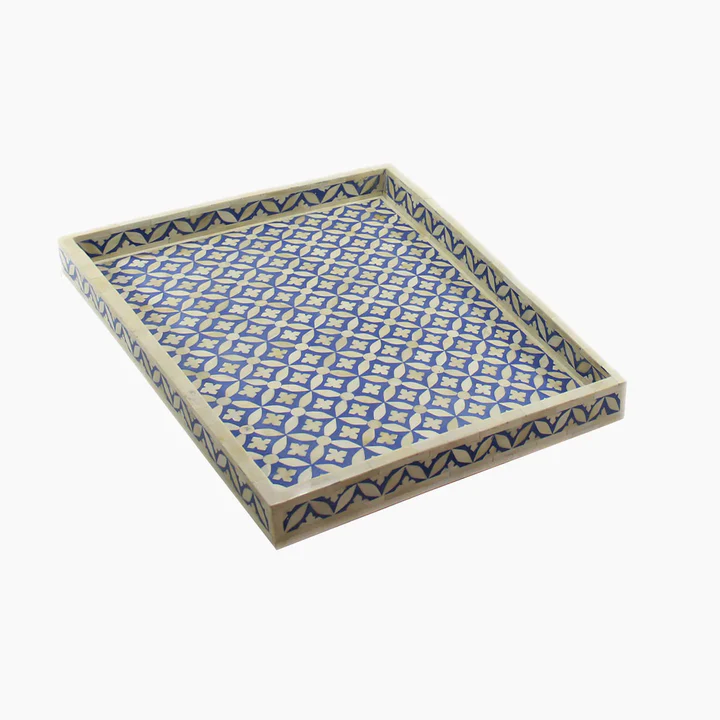The Art of Bone Inlay: Elevating Trays from Functional to Fabulous

Introduction
In the world of interior design, it’s often the small details that make the most significant impact. One such exquisite detail that has captured the attention of discerning homeowners and designers alike is bone inlay. Known for its intricate patterns and timeless appeal, bone inlay has transitioned from royal palaces and ancient artifacts to modern-day homes. Among the many applications of this artisan craft, bone inlay trays have emerged as statement pieces—transforming everyday utility into a visual celebration of craftsmanship.
A Glimpse into History
Bone inlay is an ancient decorative technique with roots tracing back over centuries to the royal courts of India and the Middle East. Traditionally used to embellish furniture and architectural elements, artisans would delicately shape pieces of camel or buffalo bone and embed them into wood or resin, forming intricate patterns that were often floral, geometric, or nature-inspired. These motifs were then filled with colored resin to create vivid contrasts and stunning visuals.
The craft was once reserved for royalty and the elite, with bone inlay adorning thrones, cabinets, and palace doors. Today, this heritage art has been reimagined for contemporary homes, blending the opulence of history with modern aesthetics—especially in the form of decorative trays.
From Utility to Art
A tray might seem like a simple household item, used primarily for serving or organizing. However, when fashioned with bone inlay, it transcends its utilitarian roots. Each bone inlay tray is a unique work of art, handcrafted over several days by skilled artisans. The process involves meticulously hand-cutting bone fragments, arranging them into detailed patterns, and filling the gaps with colored resin before polishing the final piece to perfection.
The result is a tray that does more than hold objects—it draws the eye, anchors a space, and becomes a talking point in any room. Whether perched on a coffee table with a stack of books and candles, used in the bathroom to organize perfumes and lotions, or placed on a dresser to hold jewelry, a bone inlay tray brings elegance and sophistication to its surroundings.
A Celebration of Craftsmanship
What sets bone inlay trays apart is the level of craftsmanship involved. Unlike mass-produced home accessories, these trays are often made by hand in small artisan workshops, many of which are family-run and have been practicing the technique for generations. Each piece tells a story of patience, precision, and passion.
Patterns range from traditional Mughal-inspired florals to modern chevrons and abstract motifs. The choice of resin colors—blacks, blues, greens, pastels, or even metallics—offers versatility to suit any interior palette. No two trays are exactly alike, making each piece a collector’s item in its own right.
Versatility in Decor
Bone inlay trays are not just beautiful; they’re incredibly versatile. Here are a few creative ways to incorporate them into your decor:
-
Coffee Table Centerpiece: Use a bone inlay tray to gather decorative items like candles, vases, or coasters. It adds structure and visual interest to your table.
-
Bar Tray: Elevate your home bar setup by arranging glassware, decanters, and mixers on a bone inlay tray. It brings a touch of luxury to cocktail hour.
-
Bathroom Elegance: Organize toiletries, rolled hand towels, or a vase of fresh flowers for a spa-like feel.
-
Entryway Organizer: Keep keys, sunglasses, and mail stylishly corralled in an inlay tray on your hallway console.
-
Bedroom Accent: Place one on a vanity or dresser to showcase perfume bottles, jewelry, or a small mirror.
This adaptability makes bone inlay trays a favorite among stylists and design lovers who appreciate both form and function.
Sustainability and Ethical Sourcing
With growing awareness around sustainability and ethical sourcing, many bone inlay producers now ensure their materials are responsibly obtained. The bone used in these trays is typically a byproduct of animals that have died naturally or are ethically sourced from meat industry waste, helping reduce environmental impact. Moreover, supporting bone inlay artisans helps preserve an age-old craft and provides livelihoods in rural communities.
When purchasing a bone inlay tray, it’s worth inquiring about the origin of the materials and the production process. Choosing to buy from reputable brands or fair-trade certified sellers ensures your decor choices align with your values.
Conclusion
The beauty of bone inlay lies in its timelessness. Unlike trends that come and go, the intricate artistry of inlay work has endured for centuries and continues to captivate. A bone inlay tray is not just a home accessory; it's a reflection of refined taste, appreciation for heritage, and support for traditional craftsmanship.
Whether you're seeking a striking gift, a conversation starter, or a distinctive piece to tie a room together, a bone inlay tray offers both elegance and authenticity. It’s proof that even the simplest objects, when infused with artistry, can become extraordinary.
- Art
- Causes
- Crafts
- Dance
- Drinks
- Film
- Fitness
- Food
- Spiele
- Gardening
- Health
- Home
- Literature
- Music
- Networking
- Other
- Party
- Religion
- Shopping
- Sports
- Theater
- Wellness


